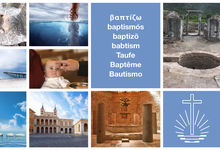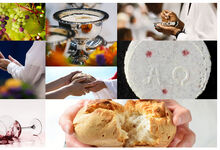The sacraments (45): One baptism, two sacraments
The rebirth out of water and Spirit: what began as a rite in two parts developed into two independent sacraments. The catalyst was the overwhelming success of Christendom.

We are in the fourth century. The baptistries that adjoined the episcopal churches were abuzz with activity. Things really took off when Emperor Constantine himself converted to Christianity, thus paving the way for the state religion.
The trend towards infant baptism, which finally gained acceptance in the sixth century, led to a further rush. Here it was the Church Father Augustine who laid the theological foundations with his doctrine of original sin.
These developments brought about a change in the two-part rite of baptism: water baptism until then—mostly performed by a priest—was immediately followed by the laying on of hands and anointing by the bishop, as confirmation (Latin confirmatio).
Priests cannot always help
Priests were available in sufficient number. But at some point, the bishops were struggling to cope with the growing numbers. The Churches in the east and west of the Roman Empire resolved this issue in very different ways.
In the Eastern Church, anointing had long enjoyed a higher status than the laying of hands. The clergy thus considered it sufficient if the oil used in anointing had been consecrated by a bishop. The bishop himself no longer had to be present for the baptism—something the Orthodox Churches still practise to this day.
In the western part of the Roman Empire things were different. The most important thing here was the laying on of hands—in keeping with biblical models—which was to ensure the doctrinal link with the biblical apostles. The bishop could therefore not delegate the act to the priests.
Just a question of time
As more and more congregations came into being, the flock soon no longer came to the shepherd, but the shepherd to the flock: the bishop visited his increasing number of parishes on horseback. And it could be days, weeks, or even years before he managed to return to the same place.
Thus the intervals between baptism and laying on of hands/anointing grew larger and larger, and the rite of confirmation became the independent sacrament of confirmation. The scholastics built the theological framework for this in the Middle Ages. This understanding was consolidated when the reformers began to shake the doctrinal edifice.
The age of the confirmands fluctuated considerably in the course of the centuries: anywhere from four to sixteen; most, however, were around seven years old. Today, confirmation may be administered on reaching the age of reason, considered to be the age when one has the ability to make decisions. The exact point in time is left to the discretion of the national conference of bishops.
The bestowal of the Holy Spirit and divine filiation
“Confirmation perfects baptismal grace,” the Catechism of the Catholic Church says. “It is the sacrament which gives the Holy Spirit.” It is to root the believers more deeply in the divine filiation, strengthen their bond with the Church, and help them “bear witness to the Christian faith in words accompanied by deeds”.
By way of comparison, the Catechism of the New Apostolic Church states: “At Holy Sealing a human being is enduringly filled with the Holy Spirit.” Thus “the rebirth out of water and the Spirit, which was begun by God in Holy Baptism with water, is completed through Holy Sealing”. And: “The effect of the rebirth out of water and the Spirit is childhood in God as well as the calling to be a firstling. If the sealed soul gives the Holy Spirit room to unfold, divine virtues will develop.”
The Protestant reformers had their fair share of problems with Catholic confirmation. And yet they went on to develop something similar: the Protestant confirmation. It was only later that the content of this act changed. This is going to be the subject of our next article in this series..
Photo: oatawa -stock.adobe.com











